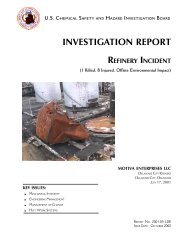Little General Store Propane Explosion - US Chemical Safety and ...
Little General Store Propane Explosion - US Chemical Safety and ...
Little General Store Propane Explosion - US Chemical Safety and ...
You also want an ePaper? Increase the reach of your titles
YUMPU automatically turns print PDFs into web optimized ePapers that Google loves.
<strong>Little</strong> <strong>General</strong> <strong>Store</strong> September 2008<br />
The morning of the explosion, a junior propane service technician 1 (junior technician) from Appalachian<br />
Heating was preparing to transfer liquid propane from an existing tank owned by Ferrellgas to a newly<br />
installed tank 2 owned by Thompson Gas <strong>and</strong> Electric Services (Thompson). The Ferrellgas propane tank<br />
was installed in 1994 directly against the store’s exterior back wall (Figure 2). At about 10:25 am, the<br />
junior technician, working alone, removed a threaded plug from the liquid withdrawal valve 3 on the<br />
Ferrellgas tank <strong>and</strong> liquid propane began flowing uncontrollably. Liquid propane sprayed upward,<br />
against the roof overhang, <strong>and</strong> dense propane gas accumulated at ground level around the tank <strong>and</strong> the<br />
foundation of the building. Over the next 25 minutes, the escaping propane entered the <strong>Little</strong> <strong>General</strong><br />
store through openings in the roof overhang.<br />
Shortly after the release began, the junior technician called the lead technician to report the release <strong>and</strong><br />
seek guidance. At 10:40 am, the junior technician called 911 to report the emergency <strong>and</strong> summon help.<br />
A captain <strong>and</strong> two emergency medical technicians from the Ghent Volunteer Fire Department were the<br />
first to arrive, followed by the lead technician <strong>and</strong> two other emergency responders. Shortly after their<br />
arrival, the propane in the store ignited, leveling it <strong>and</strong> killing two emergency responders (the fire captain<br />
<strong>and</strong> one of the emergency medical technicians) <strong>and</strong> the two Appalachian Heating propane service<br />
technicians.<br />
1<br />
The report discusses the activities of two propane service technicians: a junior technician, who had been<br />
performing propane duties for one <strong>and</strong> a half months, <strong>and</strong> a lead technician, who had been performing propane<br />
duties for one <strong>and</strong> a half years. “Junior” <strong>and</strong> “lead” are used in this report to differentiate the technicians’ relative<br />
experience in propane service.<br />
2<br />
While commonly referred to as tanks, both of these were 500-gallon pressure vessels. The American Society of<br />
Mechanical Engineers (ASME) publishes the Boiler <strong>and</strong> Pressure Vessel code; generally, stationary propane tanks<br />
are considered unfired pressure vessels <strong>and</strong> manufactured in accordance with Section VIII of the code.<br />
3<br />
The liquid withdrawal valve was a RegO Chek-Lok valve model number 7572FC, which is no longer<br />
manufactured. Although the RegO name is still used on propane equipment, the company that manufactured this<br />
valve is no longer in business.<br />
5









